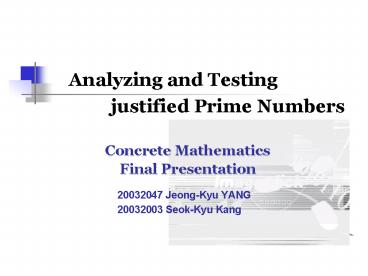Analyzing and Testing justified Prime Numbers PowerPoint PPT Presentation
1 / 19
Title: Analyzing and Testing justified Prime Numbers
1
Analyzing and Testing
justified Prime Numbers
- Concrete Mathematics
- Final Presentation
- 20032047 Jeong-Kyu YANG
- 20032003 Seok-Kyu Kang
2
OUTLINE
- Introduction
- The Primality Testing Algorithms
- Probabilistic Algorithms
- Deterministic Algorithms
- Analyzing
- Solovay-Strassen Algorithm
- Miller-Rabin Algorithm
- AKS Algorithm
- Implements Experiments
- Conclusion Future Works
- References
3
Introduction
- What is Prime Number Primality Testing?
- Prime Number
- Primality Test
- The importance of testing primality
- Applications in cryptography
- RSA, etc. uses primality testing algorithm in the
part of key generation. - How fast and efficient?
- Brief History
- 200 BC Eratosthenes Sieve
- 1976 NP(Nondeterministic Polynomial-time), Pratt
- 1977 coRP(Complementary Randomized
Polynomial-time), Solovay and Strassen - 1987 RP(Randomized Polynomial-time), adleman and
Huang - 1992 UP(Unambiguous Polynomial-time), Fellows
and Koblitz - 2002 PRIMES is in P(Polynomial-time), Agrawal et
al.
4
The Primality Testing Algorithms
- Probabilistic Algorithms
- Lehamann-Peralta
- Solovay-Strassen
- Miller-Rabin
- Deterministic Algorithms
- Eratosthenes Sieve
- Euclidean algorithm
- Fermats Theorem
- Wilsons Theorem
- AKS
5
Analyzing of Solovay-Strassen
- Probabilistic Algorithms
- Solovay-Strassen Algorithm (Cont.)
- Based on Euler Pseudoprime
- More effective than the simpler Fermats test
- A number N called an Euler Pseudoprime to base b,
- if b(N-1)/2 (b/N) (mod N).
- ((b/N) is the Jacobi symbol)
- Legendre symbol, L(a,P)
6
Analyzing of Solovay-Strassen
- Probabilistic Algorithms
- Solovay-Strassen Algorithm
7
Analyzing of Miller-Rabin
- Probabilistic Algorithms
- Miller-Rabin Algorithm (Cont.)
- More efficient than Solovay-Strassen Algorithm
- Emerged by Miller in 1976, modified by Rabin in
1980 - Definitely correct if it returns COMPOSITE, input
a maybe - a pseudoprime if it returns PRIME
- The probability of Miller-Rabin is not greater
than (1/4)s - Strong primality test of pseudoprime
8
Analyzing of Miller-Rabin
- Probabilistic Algorithms
- Miller-Rabin Algorithm
Reducing the probability of misjudgment
9
Analyzing of AKS
- Deterministic Algorithm
- AKS Algorithm
- By Manindra Agrawal, Neeraj Kyal and Nitin Saxena
- August 2002
- Always returns right answer
- Works in polynomial time
- Basic Idea
- (x a)n xn a (mod n)
- a, n relatively prime
- if n is prime true
- if n is composite false
- Compare n coefficients O(n) O(2lg n)
10
Analyzing of AKS
- Deterministic Algorithm
- AKS Algorithm
11
Analyzing of AKS
- Deterministic Algorithm
- AKS Algorithm
12
Analyzing of AKS
- Complexity
- Filter 1 O(log n)3
- Filter 2 O(log n)3
- Filter 3
- Computation ai mod n0 for all 0ltiltn.
- Using square and multiply method requires O(log
n) - multiplications of polynomials of degree
smaller than r - Multiplication of 2 such polynomials, takes
O(r2) - operations in Z/nZ, whereas, multiplication in
Z/nZ is - O(log n)2 additions.
- Then the for loop requires
- O(s r2log n(log n)2)O(2sqrt r log n r2log
n(log n)2), - r is O((log n)6) gt O((log n)19)
- O((log n)12f(log log n)), where f is a polynomial
function
13
Implementations SS, MR and AKS
- Environment
- Hardware
- Pentium III 550mhz, 384 RAM
- Language Java (j2sdk1.4.0_02), Boland Jbuilder
6.0 - The way to implement
- Solovay-Strassen Miller-Rabin
- Run simultaneously with a same random number
generator - Same iterations to check better performance
- Same bit lengths
- Demo Program-1
- AKS
- Testing with far smaller lengths (Long integer
operation is for further works) - Testing for polynomial time of AKS
- Demo Program-2, Program-3
14
Experiments - Probabilistic
- Comparison of primality between Solovay-Strassen
and Miller-Rabin
15
Experiments - Deterministic
- Testing for polynomial time of AKS
- Limitations with no memory fluctuation
- n 524287
- powerTest output r23159, s5784
- polyTest each for-loop iteration of the
for-loop takes about 355sec (about 6mins). So,
overall runtime is 6mins5784 (value of s in this
case), which is about 34704mins 578.4hours 24
days!!! - Solovay-Strassen Miller-Rabin less than 1 sec.
16
Experiments Comparison
- Primality Comparisons among tree algorithms
- Limitations
- The range of Positive Odd Integers 3 499
- Iterations 130 (SS MR also has 50 iterations
internally)
17
Conclusion
- The importance of strong very big prime numbers
from the experiments of this project - Miller-Rabin has better performance than
Solovay-Strassen - However, two algorithms probably declare lots of
pseudoprimes - AKS is a breakthrough result
- Always declares real primes
- Solves a long-standing theoretical problem
- AKS has no practical relevance
- Prohibitively slow runtimes
- Not likely to change any time soon
- Polynomial computations are just too inefficient
- Theoretically correctness V.S. practical
efficiency? - Depend on purposes
18
Future Works
- More analysis of complexity for each algorithms
- Further Experiments for AKS
- Find useful prime numbers and analyze its
characteristics - Further Implementation for AKS
- Try to get over inefficiency of AKS Algorithm
- Improving to handle very long integers
- Continue to compare results of each algorithms
19
References
- 1 M.Agrawal, N.Kayal and N.Saxena, PRIMES is
in P, August 6, 2002 - 2 William Stallings, Cryptography and Network
security, second edition. Prentice Hall, 1998 - 3 J.Menezes, C.vaz Oorschot and A.Vanstone,
Handbook of Applied Cryptography CRC,1977 - 4 Takeshi Aoyama, Polynomial Time Primality
Testing Algorithm, 2003 - 5 Frontline. Volume19-Issue 17, August
17-30.2002 - 6 http//www.javastudy.co.kr/docs/techtips/02082
1.html - 7 http//www-fs.informatik.uni-uebingen.de/rein
hard/krypto/primzt.html - 8 http//www.cse.iitk.ac.in/news/primality.html
- 9 http//random.mat.sbg.ac.at/generators/

